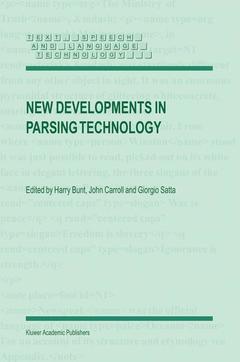Preface. 1: Developments in Parsing Technology: From Theory to Application; H. Bunt, J. Carroll, G. Satta. 1. Introduction. 2. About this book. 2: Parameter Estimation for Statistical Parsing Models: Theory and Practice of Distribution-Free Methods; M. Collins. 1. Introduction. 2. Linear Models. 3. Probabilistic Context-Free Grammars. 4. Statistical Learning Theory. 5. Convergence Bounds for Finite Sets of Hypotheses. 6. Convergence Bounds for Hyperplane Classifiers. 7. Application of Margin Analysis to Parsing. 8. Algorithms. 9. Discussion. 10. Conclusions. 3: High Precision Extraction of Grammatical Relations; J. Carroll, T. Briscoe. 1. Introduction. 2. The Analysis System. 3. Empirical Results. 4. Conclusions and Further Work. 4: Automated Extraction of TAGs from the Penn Treebank; J. Chen, K.V. Shanker. 1. Introduction. 2. Tree Extraction Procedure. 3. Evaluation. 4. Extended Extracted Grammars. 5. Related Work. 6. Conclusions. 5: Computing the Most Probable Parse for a Discontinuous Phrase-Structure Grammar; O. Plaehn. 1. Introduction. 2. Discontinuous Phrase-Structure Grammar. 3. The Parsing Algorithm. 4. Computing the Most Probable Parse. 5. Experiments. 6. Conclusion and Future Work. 6: A Neural Network Parser that Handles Sparse Data; J. Henderson. 1. Introduction. 2. Simple Synchrony Networks. 3. A Probabilistic Parser for SSNs. 4. Estimating the Probabilities with a Simple Synchrony Network. 5. Generalizing from Sparse Data. 6. Conclusion. 7: An Efficient LR Parser Generator for Tree-Adjoining Grammars; C.A. Prolo. 1. Introduction. 2. TAGS. 3. On Some Degenerate LR Models for TAGS. 4. Proposed Algorithm. 5. Implementation. 6. Example. 7. Some Properties Of the Algorithms. 8. Evaluation. 9. Conclusions. 8: Relating Tabular Parsing Algorithms for LIG and TAG; M.A. Alonso, E. de la Clergerie, V.J. Díaz, M. Vilares. 1. Introduction. 2. Tree-Adjoining Grammars. 3. Linear Indexed Grammars. 4. Bottom-upParsing Algorithms. 5. Barley-like Parsing Algorithms. 6. Barley-like Parsing Algorithms Preserving the Correct Prefix Property. 7. Bidirectional Parsing. 8. Specialized TAG parsers. 9. Conclusion. 9: Improved Left-Corner Chart Parsing for Large Context-Free Grammars; R.C. Moore. 1. Introduction. 2. Evaluating Parsing Algorithms. 3. Terminology and Notation. 4. Test Grammars. 5. Left-Corner Parsing Algorithms and Refinements. 6. Grammar Transformations. 7. Extracting Parses from the Chart. 8. Comparison to Other Algorithms. 9. Conclusions. 10: On Two Classes of Feature Paths in Large-Scale Unification Grammars; L. Ciortuz. 1. Introduction. 2. Compiling the Quick Check Filter. 3. Generalised Rule Reduction. 4. Conclusion. 11: A Context-Free Superset Approximation of Unification-Based Grammars; B. Kiefer, H.-U. Krieger. 1. Introduction. 2. Basic Inventory. 3. Approximation as Fixpoint Construction. 4. The Basic Algorithm. 5. Implementation Issues and Optimizations. 6. Revisiting the Fixpoint Construction. 7. Three Grammars. 8. Disambiguation of UBGs via Probabilistic Approximations. 12: A Recognizer for Minimalist Languages; H. Harkema. 1. Introduction. 2. Minimalist Grammars. 3. Specification of the Recognizer. 4. Correctness. 5. Complexity Results. 6. Conclusions and Future Work. 13: Range Concatenation Grammars; P. Boullier. 1. Introduction. 2. Positive Range Concatenation Grammars. 3. Negative Range Concatenation Grammars. 4. A Parsing Algorithm for RCGs. 5. Closure Properties and Modularity. 6. Conclusion. 14: Grammar Induction by MDL-Based Distributional Classification; Yikun Guo, Fuliang Weng, Lide Wu. 1. Introduction. 2. Grammar Induction with the MDL Principle. 3. Induction Strategies. 4. MDL Induction by Dynamic Distributional Classification (DCC). 5. Comparison and Conclusion. Appendix. 15: Optimal Ambiguity Packing in Context-Free Parsers with Interleaved Unification; A. Lavie, C. Penstein Rosé. 1.



